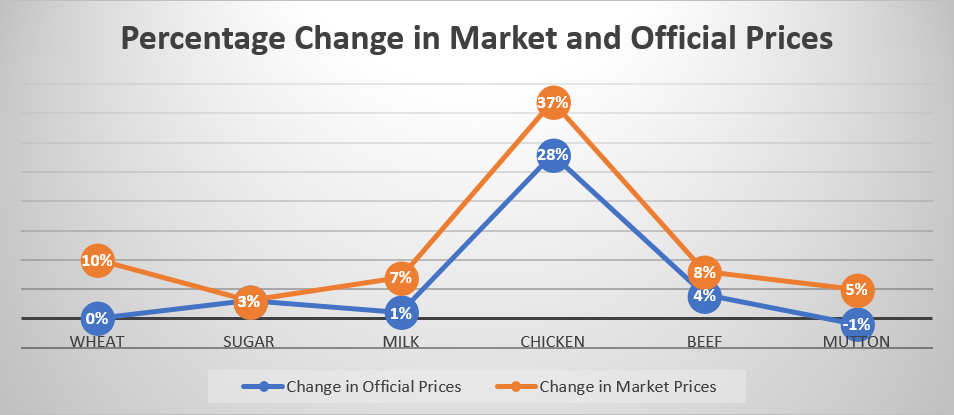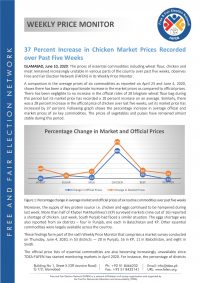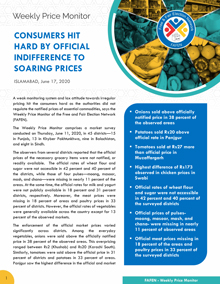ISLAMABAD, June 10, 2020: The prices of essential commodities including wheat flour, chicken, and meat remained increasingly unstable in various parts of the country over past five weeks, observes Free and Fair Election Network (FAFEN) in its Weekly Price Monitor.
A comparison in the average prices of six commodities as reported on April 23 and June 4, 2020, shows there has been a disproportionate increase in the market prices as compared to official prices. There has been negligible to no increase in the official rates of 20-kilogram wheat flour bag during this period but its market price has recorded a 10 percent increase on an average. Similarly, there was a 28 percent increase in the official price of chicken over last five weeks, yet its market price has increased by 37 percent. The following graph shows the percentage increase in average official and market prices of six key commodities. The prices of vegetables and pulses have remained almost stable during this period.

Figure 1: Percentage change in average market and official prices of six routine commodities over past five weeks
Moreover, the supply of key protein source i.e. chicken and eggs continued to be hampered during last week. More than half of Khyber Pakhtunkhwa’s (KP) surveyed markets (nine out of 16) reported a shortage of chicken. Last week, South Punjab had faced a similar situation. The egg shortage was also reported from six districts – four in Punjab, one each in Balochistan, and KP. Other essential commodities were largely available across the country.
These findings form part of the sixth Weekly Price Monitor that comprises a market survey conducted on Thursday, June 4, 2020, in 53 cities — 20 in Punjab, 16 in KP, 10 in Balochistan, and seven in Sindh.
The official price lists of essential commodities are also becoming increasingly unavailable since TDEA-FAFEN has started monitoring markets in April 2020. For instance, the percentage of districts where official sugar prices were inaccessible has increased from 44 percent to 49 percent. Similarly, the enforcement of official prices has weakened over time. The percentage of districts where official prices of 20-kilogram wheat flour bag were not followed has increased from 27 percent to 45 percent since April. Similarly, the percentage of districts where chicken was overpriced increased from 21 percent to 30 percent.
During the last week, the official price of per kilogram sugar were not publicly accessible in nearly 49 percent markets. Similarly, the official prices of wheat flour and chicken were not displayed in around 38 percent and 30 percent of the markets. The official prices of pulses – mong, masoor, mash, and chana – were inaccessible in 11 percent to 15 percent of the surveyed markets. At the same time, the prices of milk and yogurt were not publicly accessible in 23 percent and 30 percent districts, respectively. Moreover, the meat – both mutton and beef – prices were missing in 13 percent of the districts. The official price lists of routine vegetables – potatoes, onion and tomatoes – were found inaccessible in 11 percent of the observed markets in Balochistan and Sindh.
The enforcement of official prices continues to paint a grim picture for the common citizens. Several commodities are being sold at a higher price than the officially notified prices. The four pulses were being sold at a higher price than the officially notified price in around two-thirds of the surveyed districts. The overpricing ranged between Rs. 35 and Rs. 180 for mong, Rs. 32 and Rs. 143 for mash, Rs. 35 and 104 for masoor, and Rs. 34 and Rs. 78 for chana. Karachi South remained the costliest city for pulse-shopping. Among the everyday vegetables, potatoes were overpriced in 53 percent districts, onions in 43 percent districts, and tomatoes in 36 percent districts. The overpricing in vegetables went as up as Rs. 35 in case of potatoes and onions and Rs. 60 in case of tomatoes. Killa Abdullah in Balochistan was most pricey district for vegetable shopping.
In the meat category, beef and mutton (average quality with bone) were overpriced in 60 percent and 57 percent districts, while the chicken was overpriced in 36 percent districts. Mutton, beef and chicken were priced Rs. 990, Rs. 440, and Rs. 112 above the official rates, respectively. Karachi South remained the most expensive market for meat on reporting Thursday.
Wheat flour and refined sugar were sold above the official rates in 46 percent and 30 percent districts. A 20-kilogram wheat flour bag was sold Rs. 260 above the official price in Karachi South, and refined sugar Rs16 more than the market price in the same district. The market rates of eggs per dozen were above the officially notified prices in 21 percent districts. At the same time, the prices of milk and yogurt were higher than the official rates in 32 percent and 34 percent of the surveyed districts.
TDEA-FAFEN generates the weekly price monitor covering 15 essential kitchen items, including groceries such as wheat, pulses, oil, sugar, and perishable commodities like meat, and vegetables. It does this considering the need for an independent and regular assessment of the availability of such items. The observers obtained the official prices from the officials of district administrations, or market committees, and collected the wholesale prices through market surveys. In the case of Punjab, the government price app ‘Qeemat Punjab’ was also used to fetch the official rates.




